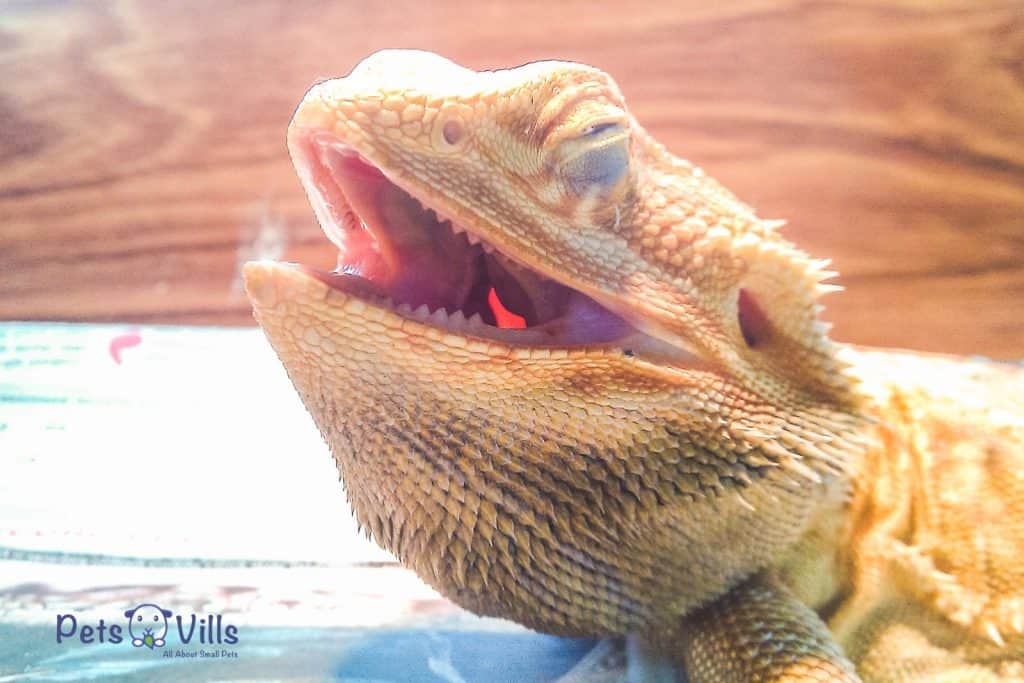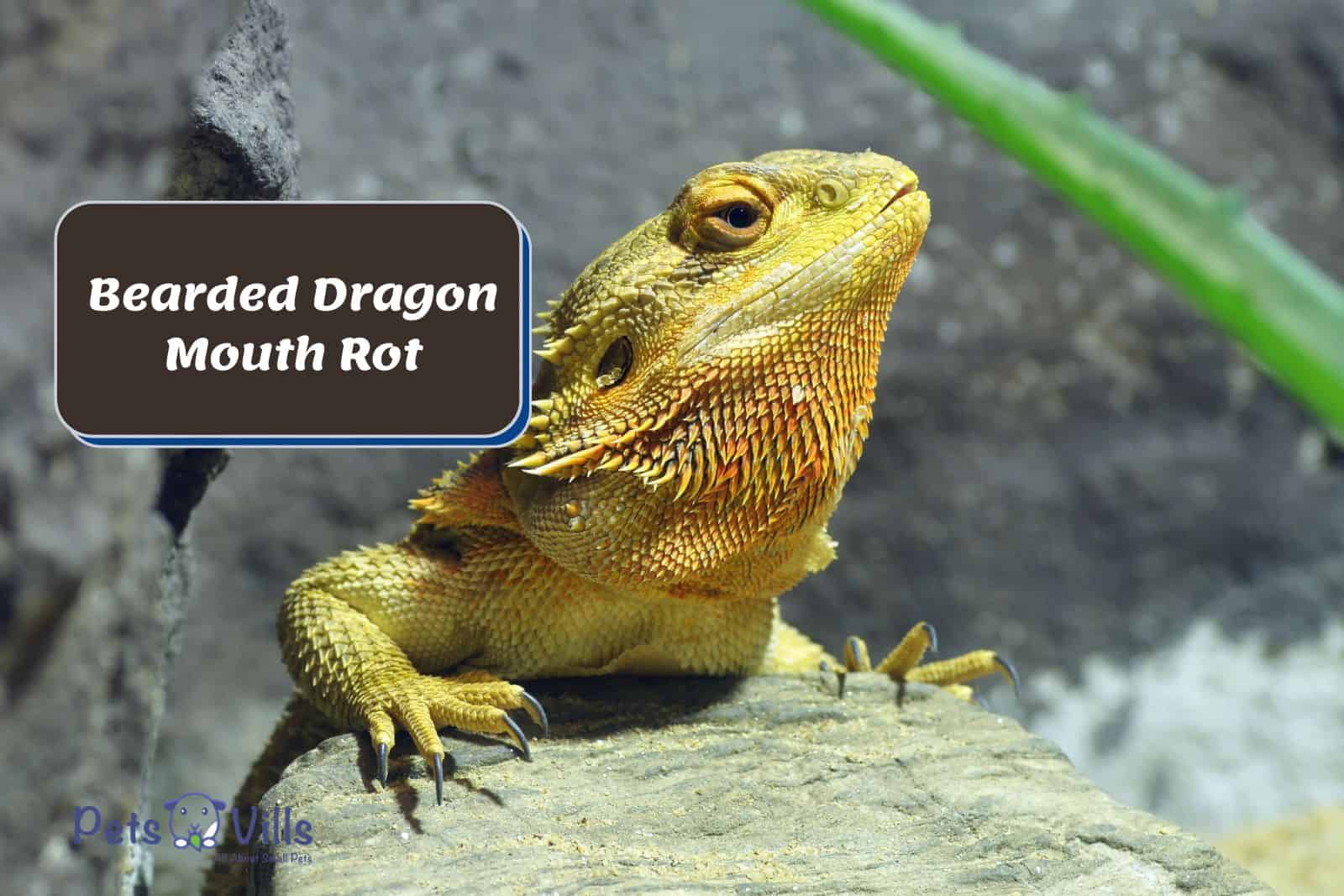Bearded dragon mouth rot is a popular topic among beardie owners. It’s easy to see why considering it sounds terrifying.
So I often hear questions about what it is and how worried owners should be about it.
Anyone with those questions has come to the right place. I’ll dive into both topics below while covering several others about this condition.
Read on, and learn everything you ever wanted to know about bearded dragon mouth rot.
Also Check: 7 Interesting Facts About Bearded Dragons
Table of Contents
Quick Summary
- Mouth rot is an infection in a bearded dragon’s mouth and gums. It causes severe discomfort and can turn fatal if left untreated.
- A few telltale signs of mouth rot include loss in appetite, bloating, and yellow patches inside your beardie’s mouth.
- Preventing mouth rot is about providing your bearded dragon with proper care, a healthy diet, and routine tooth brushing.
- Likewise, it usually infects dragons with compromised immune systems living in terrible conditions. Healthy beardies are much less likely to suffer from mouth rot.
- Owners can treat early-stage mouth rot with home remedies like Betadine. But if you have any doubts, take them to your vet.
What is Considered Mouth Rot in Beardies?

Mouth rot, also called infectious stomatitis or ulcerative stomatitis, is a common condition among reptiles (1). But beardies aren’t as affected by it as iguanas or other lizards.
But it’s common enough that beardie owners need to know about it. So the simplest way to describe bearded dragon mouth rot is as an oral infection of fungal, bacterial, or viral variety.
If left untreated, this infection will attack your beardie’s jaw bone and oral tissues. It’ll then cause them severe discomfort and provide some concerning symptoms.
Sadly, this discomfort will worsen, and the condition can become fatal for beardies. It’s why owners must recognize the symptoms and address them immediately.
Our next section will discuss mouth rot’s symptoms and signs to help you identify it. I want to ensure everyone is prepared to deal with this issue if it does pop up in their beardie.
How to Tell If a Bearded Dragon Has Mouth Rot
Mouth rot isn’t a condition that’ll go under the radar. Honestly, it comes with several flashing red light-type signs.
In other words, it’ll be hard to miss if you’re checking your beardie regularly. So here’s a quick list of bearded dragon mouth rot symptoms to watch out for:
1. Yellow Patches of Rot Inside Your Beardie’s Mouth

One of the more common warning signs is yellow patches inside a beardie’s mouth. In fact, these patches are usually the first symptom people notice.
You won’t have much trouble seeing them, either. The patches won’t blend in with your beardie’s oral cavity at all.
They should stick out like a sore thumb. So if the patches pop up, you should notice them during your dragon’s routine tooth cleaning.
2. Loss of Appetite/Lack of Drinking
A bearded dragon with mouth rot is less likely to eat or drink normally. Both actions become rather painful, similar to what a toothache would do for humans.
I can’t blame them, as nothing hurts worse than eating or drinking with tooth damage. But if you notice a decrease in one or both, mouth rot could be the cause.
3. Bloating/Swelling
Dragons suffering mouth rot often become bloated or swell up in certain areas. For instance, the swelling of their face, mouth tissue, gums, and head are common.
It’ll end up making them look a bit puffer than usual. But this symptom is usually combined with a lack of appetite, so it seems somewhat abnormal.
After all, they should be getting smaller when they aren’t eating. So anyone who notices this combo should set up a vet visit to see whether mouth rot is the cause.
4. Other More Uncommon or Extreme Signs:
- Yellow pus on the inside or outside of the mouth
- Excessive and thick saliva
- Bleeding gums
- Loss of teeth or broken teeth
Any combination of these symptoms should warrant an immediate vet visit. Mouth rot isn’t a condition you should mess around with, considering its potentially fatal outcome.
How to Prevent Your Beardie From Getting Mouth Rot?
Certain prevention methods can do wonders in stopping this condition from occurring. But of course, it starts by getting your beardie yearly vet visits and taking proper care of them.
These two tasks are crucial to preventing any problematic conditions. However, here are a few mouth rot-specific measures that owners can take:
- Offering proper temperature and humidity levels in a beardie tank or enclosure
- Keeping them on a nutritious and healthy diet
- Removing any food or substrate stuck inside their mouths. A quick bruising or cotton swap will be enough for the job.
- Staying cautious when near their mouths. Bearded dragons don’t have the most stable teeth or jaws, so it’s necessary to be careful.
- Follow the proper technique when opening their mouths. I’d recommend talking with a vet about how to restrain them if you’re inexperienced.
- Removing potential stressors from their lives. Beardies react to stress by glass surfing against an enclosure which could cause tooth damage. Here’s a video showing a stressed bearded dragon glass surfing.
If you keep up with these tips and offer proper care, there won’t be much trouble with mouth rot. Your beardie will be able to avoid the situations that cause this awful condition.
But it’s essential to learn about these causes, as well. So our next section will dive into the topic to ensure your beardie can avoid contracting mouth rot.
What Causes Mouth Rot?
Pinpointing what causes mouth rot to a single reason is very difficult. Sadly, this infection can arise from several origins and cause significant problems for your beardie.
But it usually comes from terrible environmental conditions or a compromised immune system. Honestly, it’s often a combination of both when contracting mouth rot:
For instance, horrible living conditions often result in a stressed-out bearded dragon. This stress could come from a variety of sources:
- Improper temperatures or humidity level
- Poor diet or lack of clean water
- An unclean environment
- Overcrowding (2)
But all of these sources create a stressful environment. In response, your beardie will experience a “lack of sleep, loss of appetite, and other stress-related symptoms” (2).
It’ll then weaken their immune system leaving them open to contracting mouth rot. It’s why owners must pay attention to their beardie’s body language and any sign of stress.
After all, stress is the most common cause of a beardie’s compromised immune system. So owners must do whatever it takes to avoid stress in their beardie’s lives.
Otherwise, you’re inviting common diseases like mouth rot or mbd in bearded dragons to attack. Then, it’s open season, and stuck food/minor cuts become serious issues (3).
There isn’t a bearded dragon owner alive who wants that outcome.
Here are some reasons why beardie dragons hang their mouth open.
How to Treat If Your Beardie Does Get Mouth Rot?
My recommended proper treatment option will always be seeking veterinary care same as we do recommend for bearded dragon tail rot treatment. It’s much better to discuss how to fix an issue with a professional who knows your beardie.
However, I do have to note that some owners are lucky enough to catch mouth rot in the early stages. If they do, certain home remedies can treat the issue without a vet visit.
For instance, using Betadine could work wonders (4). You simply apply a small amount onto a cotton swab and place it on the infected areas.
But I’d recommend reading Betadine’s instructions before applying. Some variations will need watering down, so be cautious about them.
If Betadine doesn’t work after a few days, it’s time to see the vet for a physical exam. Your vet will then provide some injectable antibiotics to help your sick beardie.
Also Read: Do Beardies Have Teeth?
FAQs
Is mouth rot painful?
Mouth rot is very painful for our bearded dragon friends. It’s similar to what humans feel when experiencing tooth damage or other mouth-related issues.
How do you clean a bearded dragon’s mouth?
You clean a bearded dragon’s mouth by wetting a cotton bud or ball. Then, proceed to use it to wipe around their teeth and gums twice weekly.
Conclusion
Overall, bearded dragon mouth rot is a severe and dangerous condition. Pet owners must address it immediately if they see any notable symptoms of mouth rot.
But it usually doesn’t affect beardies with proper care and living conditions. So if you remain vigilant and keep them in good shape, mouth rot will likely never be an issue.

Did you ever tackle a mouth rot bearded dragon? Let us know in the comments section!
Resources
- 1. Ulcerative Stomatitis (Mouthrot) in Reptiles [Internet]. www.anapsid.org. [cited 2022 Sep 30]. Available from: https://www.anapsid.org/stomatitis.html
- 2. Dragons Down Under: The Inland Bearded Dragon [Internet]. www.anapsid.org. [cited 2022 Sep 30]. Available from: https://www.anapsid.org/bearded.html
- 3. Warren R. Bearded Dragon’s Oral Diseases Treated [Internet]. School of Veterinary Medicine. 2020 [cited 2022 Sep 30]. Available from: https://www.vetmed.ucdavis.edu/news/bearded-dragons-oral-diseases-treated
- 4. Betadine (Povidone-iodine) | Betadine [Internet]. Betadine (Povidone-iodine) | Betadine. Available from: https://www.betadine.com/

My name is Ben Roberts, and I absolutely love animals. So, naturally, I love writing about them too! As far as my animals, I have a Pit-bull, a Beagle-lab mix, a Chihuahua, and one old cat. Each one of them provides me with a new adventure every day. And the best part is they’re all best friends. Well, except the cat when he gets a little annoyed.
FIND HIM ON: FACEBOOK and TWITTER.
Read his latest ARTICLES
Learn more about Benhere


